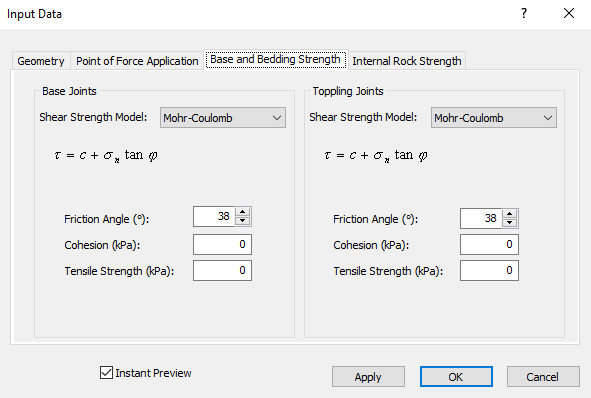Base and Bedding Strength
The shear strength of the discontinuity planes in RocTopple can be modeled using one of the following strength criteria: Mohr-Coulomb or Barton-Bandis. These strength parameters are defined in the Base and Bedding Strength tab of the Input Data dialog. To open the tab:
- Select Input Data
 on the toolbar or the Analysis menu or press F3.
on the toolbar or the Analysis menu or press F3. - Select the Base and Bedding Strength tab.

You can specify strength criteria independently for each discontinuity plane (Base Joints and Toppling Joints). Although the dialog refers to the discontinuities as "joints," the actual discontinuities in your slope model can be any type of planar discontinuity due to bedding, faults, joints, schistosity, etc.
NOTES:
- For a Probabilistic analysis, it is possible to define statistical variability of the joint strength properties. See Strength Statistic in a Probabilistic Analysis for more information.
- If water pressure is included, all parameters should be considered effective stress parameters. See the Overview of Water Pressure in RocTopple for details about including water pressure in the analysis.
Mohr-Coulomb
The Mohr-Coulomb model relates shear strength,  , and normal stress
, and normal stress  , according to Eqn.1:
, according to Eqn.1:
![]() Eqn.1
Eqn.1
where  is the friction angle of the joint plane and c is the cohesion.
is the friction angle of the joint plane and c is the cohesion.
Barton-Bandis
The original Barton equation for the shear strength of a rock joint is given by Eqn.2:
 Eqn.2
Eqn.2
where  is the basic friction angle of the failure surface, JRC is the joint roughness coefficient, and JCS is the joint wall compressive strength [Barton, 1973, 1976]. On the basis of direct shear test results for 130 samples of variably weathered rock joints, this was later revised to Eqn.3:
is the basic friction angle of the failure surface, JRC is the joint roughness coefficient, and JCS is the joint wall compressive strength [Barton, 1973, 1976]. On the basis of direct shear test results for 130 samples of variably weathered rock joints, this was later revised to Eqn.3:
 Eqn.3
Eqn.3
where  is the residual friction angle of the failure surface [Barton and Choubey, 1977]. Barton and Choubey suggest that
is the residual friction angle of the failure surface [Barton and Choubey, 1977]. Barton and Choubey suggest that  can be estimated from Eqn.4:
can be estimated from Eqn.4:
![]() Eqn.4
Eqn.4
where r is the Schmidt hammer rebound number on wet and weathered fracture surfaces and R is the Schmidt rebound number on dry unweathered sawn surfaces. Equations 3 and 4 have become part of the Barton-Bandis criterion for rock joint strength and deformability [Barton and Bandis, 1990].
NOTE: For more help on the shear strength of discontinuities, including a discussion of the Barton-Bandis failure criterion parameters, see Practical Rock Engineering (Chapter 4: Shear Strength of Discontinuities) on our website.